NUR250 S1 2018 Medical Surgical Nursing: Patient Care & Planning
VerifiedAdded on 2023/06/14
|16
|3783
|211
Report
AI Summary
This assignment provides a comprehensive patient care report focusing on a patient named Jim, admitted with suspected influenza. The report includes an initial patient assessment, highlighting key issues such as airway patency, body temperature, and breathing patterns. A detailed nursing care plan addresses potential problems like the risk of infection spread, self-care deficit, fluid imbalance, ineffective breathing, and airway clearance. The report further discusses medication management, including the use of oseltamivir, paracetamol, and the Fluvax influenza vaccine. Finally, the assignment outlines essential patient teaching strategies to ensure understanding and adherence to the treatment plan. This report is designed to demonstrate the application of nursing knowledge in a medical-surgical setting.
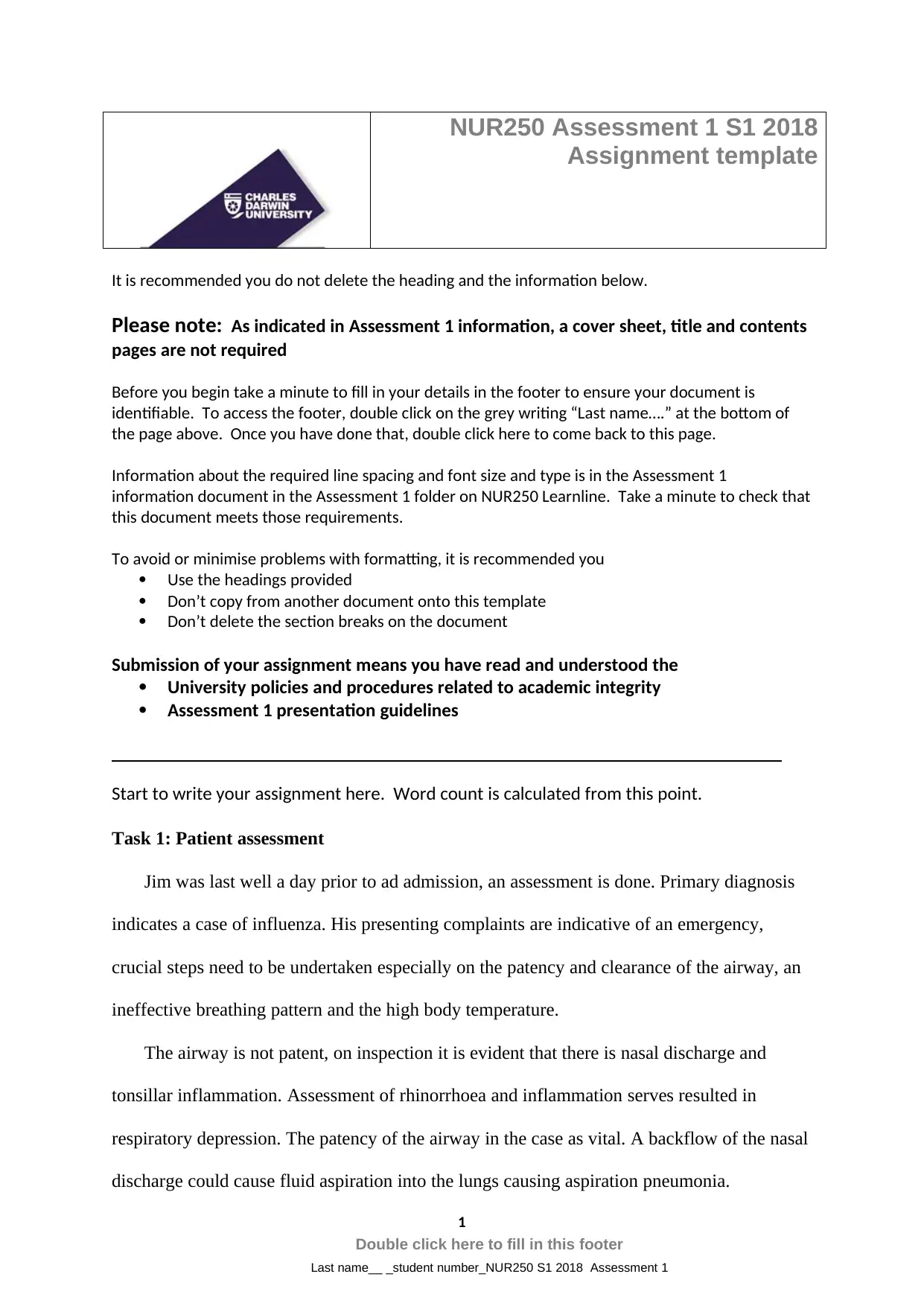
NUR250 Assessment 1 S1 2018
Assignment template
It is recommended you do not delete the heading and the information below.
Please note: As indicated in Assessment 1 information, a cover sheet, title and contents
pages are not required
Before you begin take a minute to fill in your details in the footer to ensure your document is
identifiable. To access the footer, double click on the grey writing “Last name….” at the bottom of
the page above. Once you have done that, double click here to come back to this page.
Information about the required line spacing and font size and type is in the Assessment 1
information document in the Assessment 1 folder on NUR250 Learnline. Take a minute to check that
this document meets those requirements.
To avoid or minimise problems with formatting, it is recommended you
Use the headings provided
Don’t copy from another document onto this template
Don’t delete the section breaks on the document
Submission of your assignment means you have read and understood the
University policies and procedures related to academic integrity
Assessment 1 presentation guidelines
Start to write your assignment here. Word count is calculated from this point.
Task 1: Patient assessment
Jim was last well a day prior to ad admission, an assessment is done. Primary diagnosis
indicates a case of influenza. His presenting complaints are indicative of an emergency,
crucial steps need to be undertaken especially on the patency and clearance of the airway, an
ineffective breathing pattern and the high body temperature.
The airway is not patent, on inspection it is evident that there is nasal discharge and
tonsillar inflammation. Assessment of rhinorrhoea and inflammation serves resulted in
respiratory depression. The patency of the airway in the case as vital. A backflow of the nasal
discharge could cause fluid aspiration into the lungs causing aspiration pneumonia.
1
Double click here to fill in this footer
Last name__ _student number_NUR250 S1 2018 Assessment 1
Assignment template
It is recommended you do not delete the heading and the information below.
Please note: As indicated in Assessment 1 information, a cover sheet, title and contents
pages are not required
Before you begin take a minute to fill in your details in the footer to ensure your document is
identifiable. To access the footer, double click on the grey writing “Last name….” at the bottom of
the page above. Once you have done that, double click here to come back to this page.
Information about the required line spacing and font size and type is in the Assessment 1
information document in the Assessment 1 folder on NUR250 Learnline. Take a minute to check that
this document meets those requirements.
To avoid or minimise problems with formatting, it is recommended you
Use the headings provided
Don’t copy from another document onto this template
Don’t delete the section breaks on the document
Submission of your assignment means you have read and understood the
University policies and procedures related to academic integrity
Assessment 1 presentation guidelines
Start to write your assignment here. Word count is calculated from this point.
Task 1: Patient assessment
Jim was last well a day prior to ad admission, an assessment is done. Primary diagnosis
indicates a case of influenza. His presenting complaints are indicative of an emergency,
crucial steps need to be undertaken especially on the patency and clearance of the airway, an
ineffective breathing pattern and the high body temperature.
The airway is not patent, on inspection it is evident that there is nasal discharge and
tonsillar inflammation. Assessment of rhinorrhoea and inflammation serves resulted in
respiratory depression. The patency of the airway in the case as vital. A backflow of the nasal
discharge could cause fluid aspiration into the lungs causing aspiration pneumonia.
1
Double click here to fill in this footer
Last name__ _student number_NUR250 S1 2018 Assessment 1
Paraphrase This Document
Need a fresh take? Get an instant paraphrase of this document with our AI Paraphraser
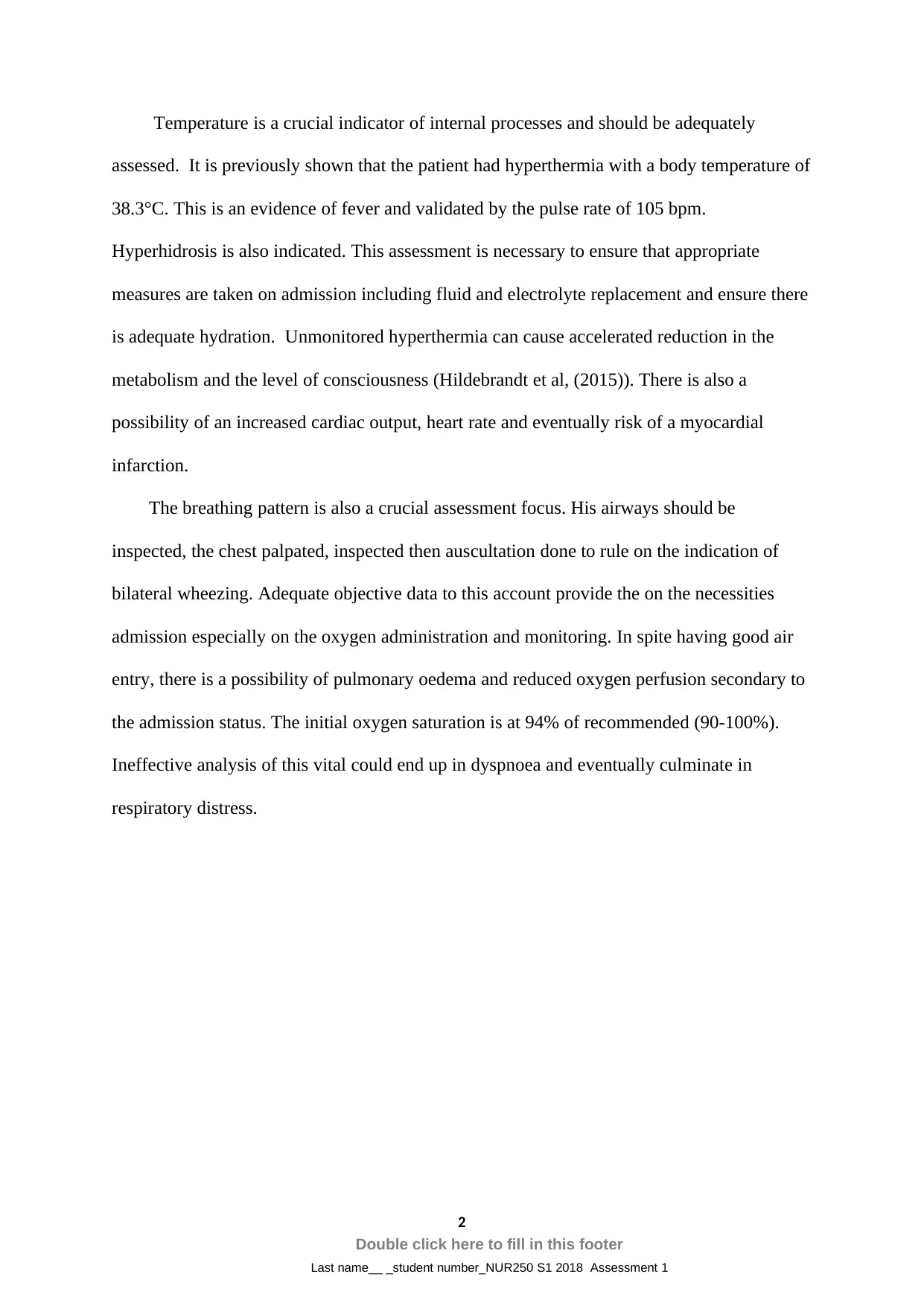
Temperature is a crucial indicator of internal processes and should be adequately
assessed. It is previously shown that the patient had hyperthermia with a body temperature of
38.3°C. This is an evidence of fever and validated by the pulse rate of 105 bpm.
Hyperhidrosis is also indicated. This assessment is necessary to ensure that appropriate
measures are taken on admission including fluid and electrolyte replacement and ensure there
is adequate hydration. Unmonitored hyperthermia can cause accelerated reduction in the
metabolism and the level of consciousness (Hildebrandt et al, (2015)). There is also a
possibility of an increased cardiac output, heart rate and eventually risk of a myocardial
infarction.
The breathing pattern is also a crucial assessment focus. His airways should be
inspected, the chest palpated, inspected then auscultation done to rule on the indication of
bilateral wheezing. Adequate objective data to this account provide the on the necessities
admission especially on the oxygen administration and monitoring. In spite having good air
entry, there is a possibility of pulmonary oedema and reduced oxygen perfusion secondary to
the admission status. The initial oxygen saturation is at 94% of recommended (90-100%).
Ineffective analysis of this vital could end up in dyspnoea and eventually culminate in
respiratory distress.
2
Double click here to fill in this footer
Last name__ _student number_NUR250 S1 2018 Assessment 1
assessed. It is previously shown that the patient had hyperthermia with a body temperature of
38.3°C. This is an evidence of fever and validated by the pulse rate of 105 bpm.
Hyperhidrosis is also indicated. This assessment is necessary to ensure that appropriate
measures are taken on admission including fluid and electrolyte replacement and ensure there
is adequate hydration. Unmonitored hyperthermia can cause accelerated reduction in the
metabolism and the level of consciousness (Hildebrandt et al, (2015)). There is also a
possibility of an increased cardiac output, heart rate and eventually risk of a myocardial
infarction.
The breathing pattern is also a crucial assessment focus. His airways should be
inspected, the chest palpated, inspected then auscultation done to rule on the indication of
bilateral wheezing. Adequate objective data to this account provide the on the necessities
admission especially on the oxygen administration and monitoring. In spite having good air
entry, there is a possibility of pulmonary oedema and reduced oxygen perfusion secondary to
the admission status. The initial oxygen saturation is at 94% of recommended (90-100%).
Ineffective analysis of this vital could end up in dyspnoea and eventually culminate in
respiratory distress.
2
Double click here to fill in this footer
Last name__ _student number_NUR250 S1 2018 Assessment 1

3
Double click here to fill in this footer
Last name__ _student number_NUR250 S1 2018 Assessment 1
Double click here to fill in this footer
Last name__ _student number_NUR250 S1 2018 Assessment 1
⊘ This is a preview!⊘
Do you want full access?
Subscribe today to unlock all pages.

Trusted by 1+ million students worldwide
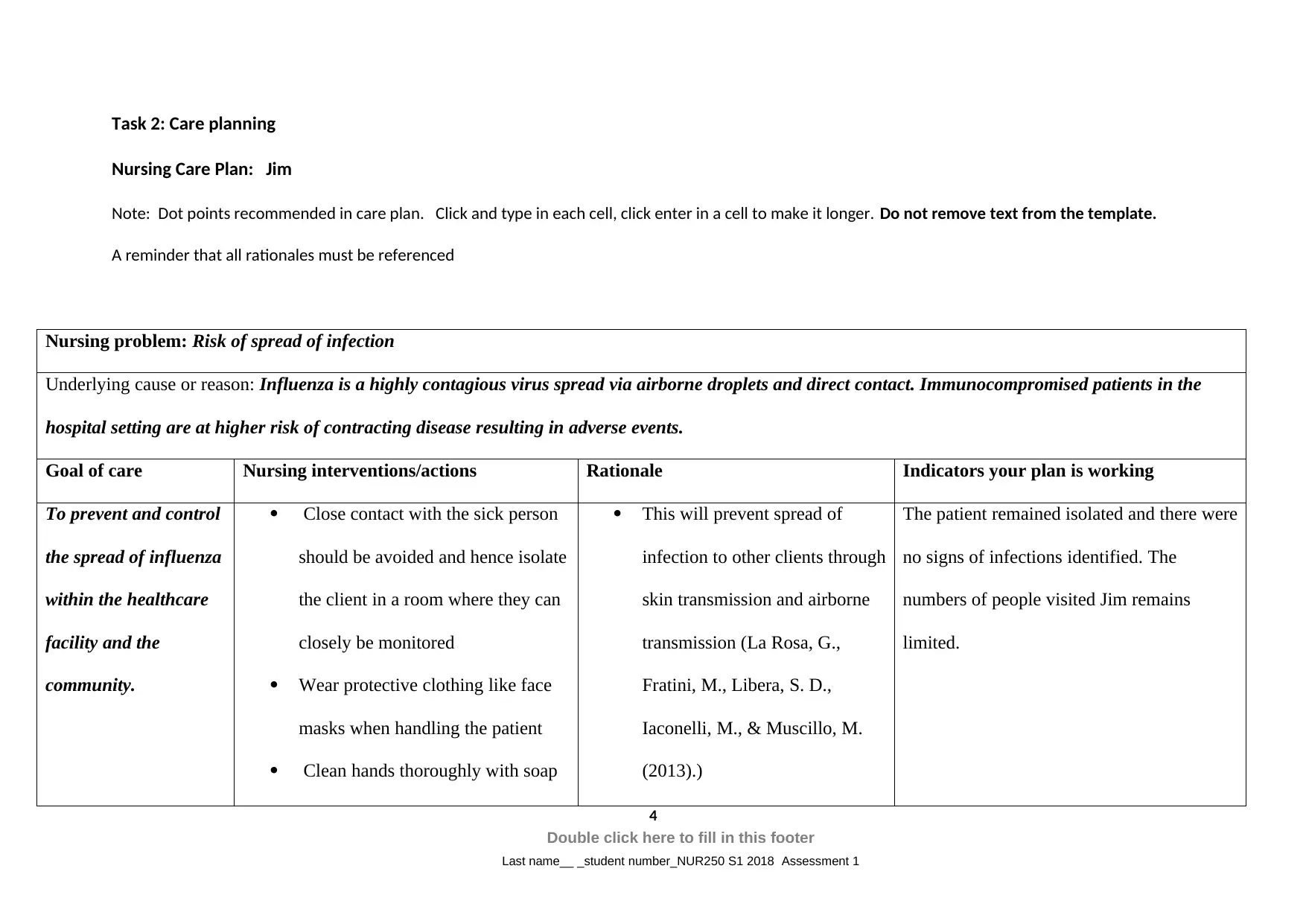
Task 2: Care planning
Nursing Care Plan: Jim
Note: Dot points recommended in care plan. Click and type in each cell, click enter in a cell to make it longer. Do not remove text from the template.
A reminder that all rationales must be referenced
Nursing problem: Risk of spread of infection
Underlying cause or reason: Influenza is a highly contagious virus spread via airborne droplets and direct contact. Immunocompromised patients in the
hospital setting are at higher risk of contracting disease resulting in adverse events.
Goal of care Nursing interventions/actions Rationale Indicators your plan is working
To prevent and control
the spread of influenza
within the healthcare
facility and the
community.
Close contact with the sick person
should be avoided and hence isolate
the client in a room where they can
closely be monitored
Wear protective clothing like face
masks when handling the patient
Clean hands thoroughly with soap
This will prevent spread of
infection to other clients through
skin transmission and airborne
transmission (La Rosa, G.,
Fratini, M., Libera, S. D.,
Iaconelli, M., & Muscillo, M.
(2013).)
The patient remained isolated and there were
no signs of infections identified. The
numbers of people visited Jim remains
limited.
4
Double click here to fill in this footer
Last name__ _student number_NUR250 S1 2018 Assessment 1
Nursing Care Plan: Jim
Note: Dot points recommended in care plan. Click and type in each cell, click enter in a cell to make it longer. Do not remove text from the template.
A reminder that all rationales must be referenced
Nursing problem: Risk of spread of infection
Underlying cause or reason: Influenza is a highly contagious virus spread via airborne droplets and direct contact. Immunocompromised patients in the
hospital setting are at higher risk of contracting disease resulting in adverse events.
Goal of care Nursing interventions/actions Rationale Indicators your plan is working
To prevent and control
the spread of influenza
within the healthcare
facility and the
community.
Close contact with the sick person
should be avoided and hence isolate
the client in a room where they can
closely be monitored
Wear protective clothing like face
masks when handling the patient
Clean hands thoroughly with soap
This will prevent spread of
infection to other clients through
skin transmission and airborne
transmission (La Rosa, G.,
Fratini, M., Libera, S. D.,
Iaconelli, M., & Muscillo, M.
(2013).)
The patient remained isolated and there were
no signs of infections identified. The
numbers of people visited Jim remains
limited.
4
Double click here to fill in this footer
Last name__ _student number_NUR250 S1 2018 Assessment 1
Paraphrase This Document
Need a fresh take? Get an instant paraphrase of this document with our AI Paraphraser
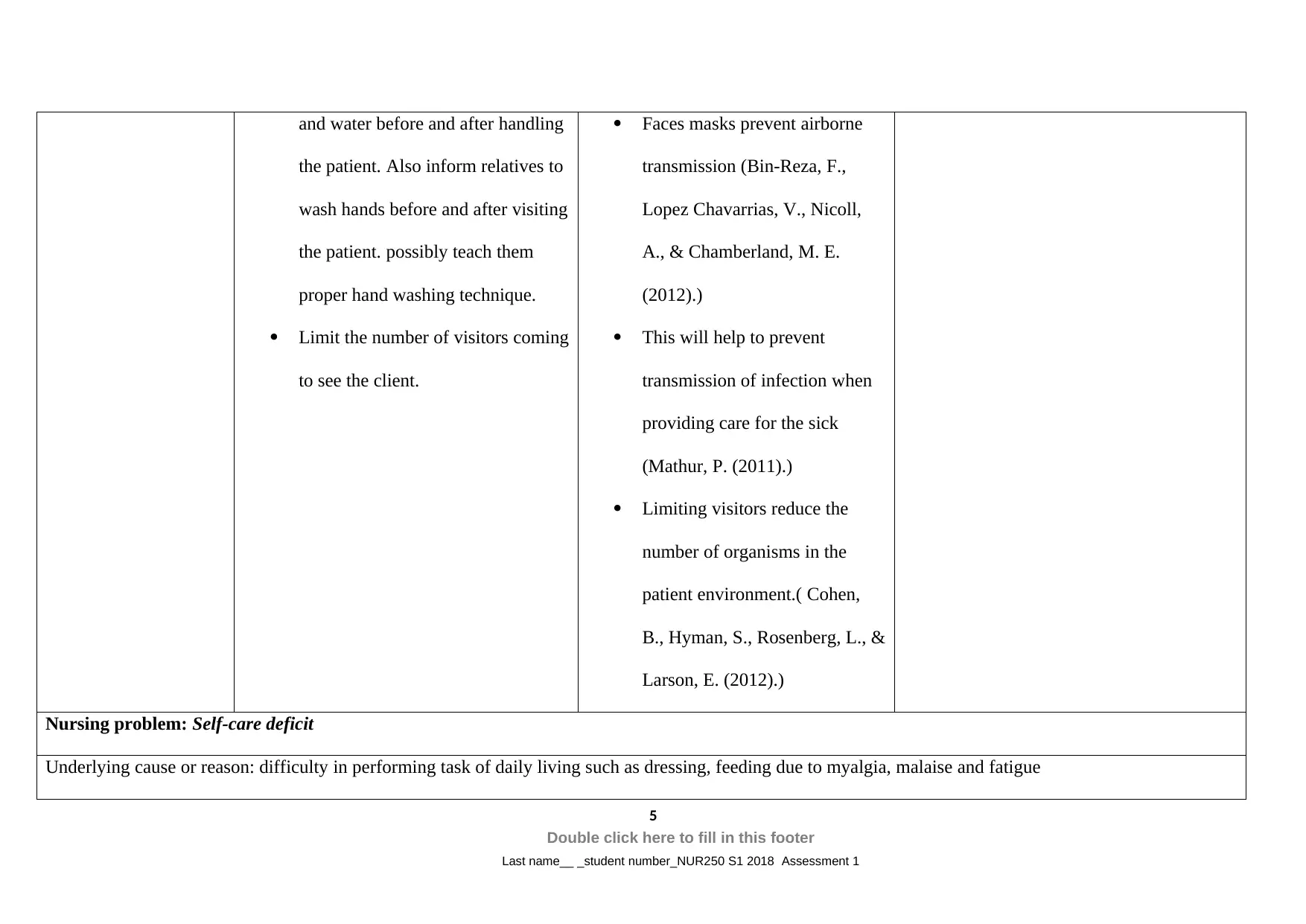
and water before and after handling
the patient. Also inform relatives to
wash hands before and after visiting
the patient. possibly teach them
proper hand washing technique.
Limit the number of visitors coming
to see the client.
Faces masks prevent airborne
transmission (Bin‐Reza, F.,
Lopez Chavarrias, V., Nicoll,
A., & Chamberland, M. E.
(2012).)
This will help to prevent
transmission of infection when
providing care for the sick
(Mathur, P. (2011).)
Limiting visitors reduce the
number of organisms in the
patient environment.( Cohen,
B., Hyman, S., Rosenberg, L., &
Larson, E. (2012).)
Nursing problem: Self-care deficit
Underlying cause or reason: difficulty in performing task of daily living such as dressing, feeding due to myalgia, malaise and fatigue
5
Double click here to fill in this footer
Last name__ _student number_NUR250 S1 2018 Assessment 1
the patient. Also inform relatives to
wash hands before and after visiting
the patient. possibly teach them
proper hand washing technique.
Limit the number of visitors coming
to see the client.
Faces masks prevent airborne
transmission (Bin‐Reza, F.,
Lopez Chavarrias, V., Nicoll,
A., & Chamberland, M. E.
(2012).)
This will help to prevent
transmission of infection when
providing care for the sick
(Mathur, P. (2011).)
Limiting visitors reduce the
number of organisms in the
patient environment.( Cohen,
B., Hyman, S., Rosenberg, L., &
Larson, E. (2012).)
Nursing problem: Self-care deficit
Underlying cause or reason: difficulty in performing task of daily living such as dressing, feeding due to myalgia, malaise and fatigue
5
Double click here to fill in this footer
Last name__ _student number_NUR250 S1 2018 Assessment 1
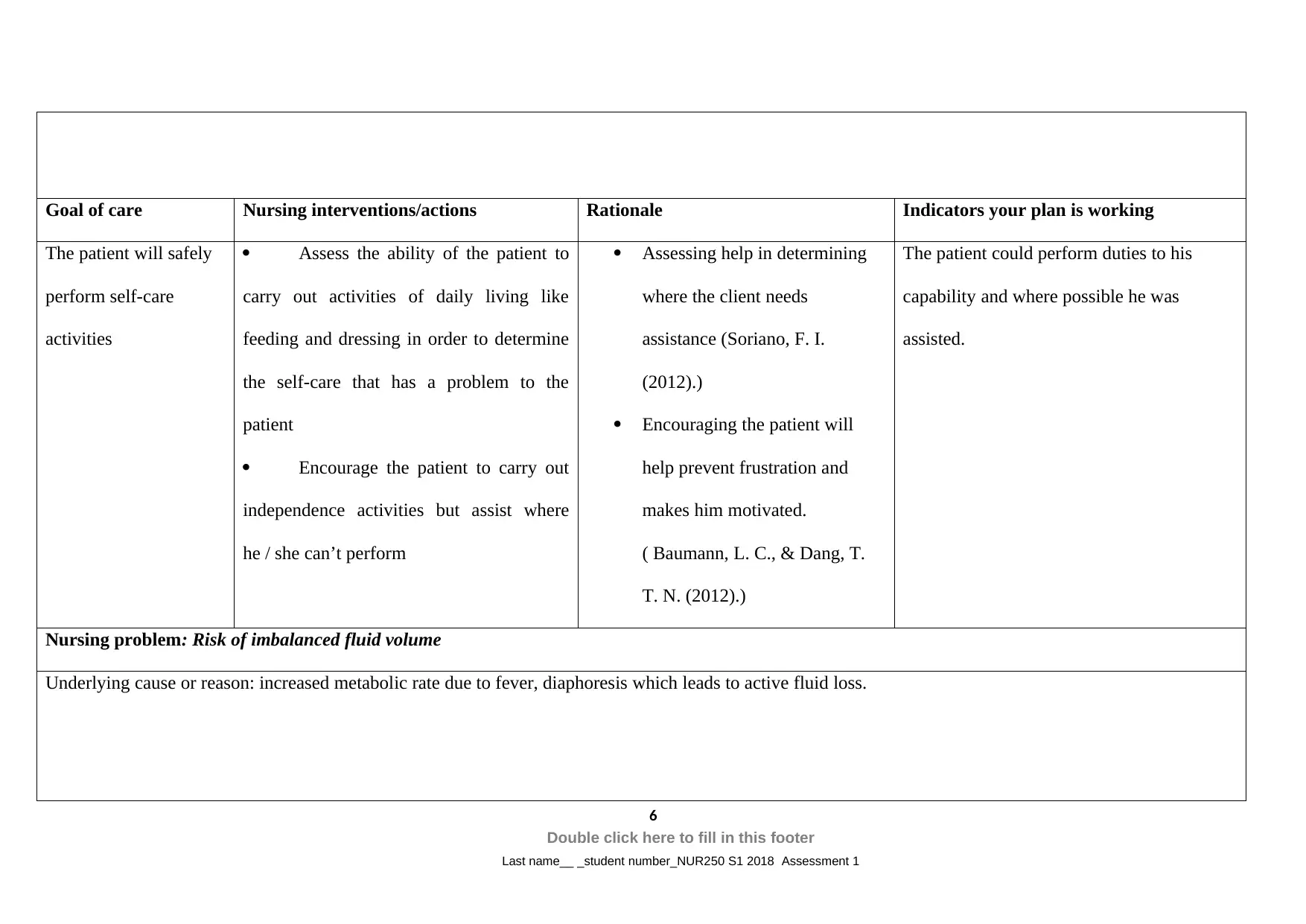
Goal of care Nursing interventions/actions Rationale Indicators your plan is working
The patient will safely
perform self-care
activities
Assess the ability of the patient to
carry out activities of daily living like
feeding and dressing in order to determine
the self-care that has a problem to the
patient
Encourage the patient to carry out
independence activities but assist where
he / she can’t perform
Assessing help in determining
where the client needs
assistance (Soriano, F. I.
(2012).)
Encouraging the patient will
help prevent frustration and
makes him motivated.
( Baumann, L. C., & Dang, T.
T. N. (2012).)
The patient could perform duties to his
capability and where possible he was
assisted.
Nursing problem: Risk of imbalanced fluid volume
Underlying cause or reason: increased metabolic rate due to fever, diaphoresis which leads to active fluid loss.
6
Double click here to fill in this footer
Last name__ _student number_NUR250 S1 2018 Assessment 1
The patient will safely
perform self-care
activities
Assess the ability of the patient to
carry out activities of daily living like
feeding and dressing in order to determine
the self-care that has a problem to the
patient
Encourage the patient to carry out
independence activities but assist where
he / she can’t perform
Assessing help in determining
where the client needs
assistance (Soriano, F. I.
(2012).)
Encouraging the patient will
help prevent frustration and
makes him motivated.
( Baumann, L. C., & Dang, T.
T. N. (2012).)
The patient could perform duties to his
capability and where possible he was
assisted.
Nursing problem: Risk of imbalanced fluid volume
Underlying cause or reason: increased metabolic rate due to fever, diaphoresis which leads to active fluid loss.
6
Double click here to fill in this footer
Last name__ _student number_NUR250 S1 2018 Assessment 1
⊘ This is a preview!⊘
Do you want full access?
Subscribe today to unlock all pages.

Trusted by 1+ million students worldwide
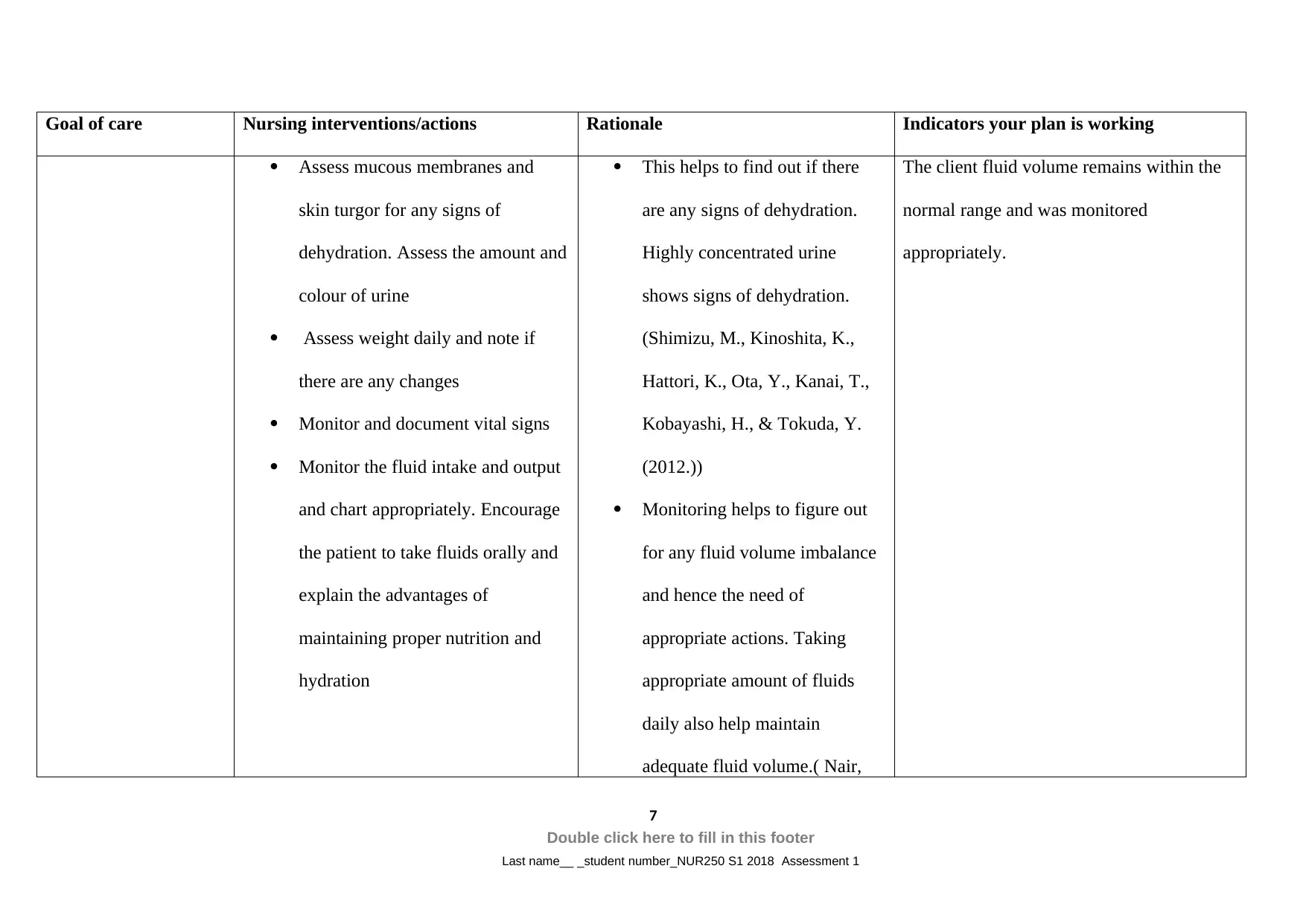
Goal of care Nursing interventions/actions Rationale Indicators your plan is working
Assess mucous membranes and
skin turgor for any signs of
dehydration. Assess the amount and
colour of urine
Assess weight daily and note if
there are any changes
Monitor and document vital signs
Monitor the fluid intake and output
and chart appropriately. Encourage
the patient to take fluids orally and
explain the advantages of
maintaining proper nutrition and
hydration
This helps to find out if there
are any signs of dehydration.
Highly concentrated urine
shows signs of dehydration.
(Shimizu, M., Kinoshita, K.,
Hattori, K., Ota, Y., Kanai, T.,
Kobayashi, H., & Tokuda, Y.
(2012.))
Monitoring helps to figure out
for any fluid volume imbalance
and hence the need of
appropriate actions. Taking
appropriate amount of fluids
daily also help maintain
adequate fluid volume.( Nair,
The client fluid volume remains within the
normal range and was monitored
appropriately.
7
Double click here to fill in this footer
Last name__ _student number_NUR250 S1 2018 Assessment 1
Assess mucous membranes and
skin turgor for any signs of
dehydration. Assess the amount and
colour of urine
Assess weight daily and note if
there are any changes
Monitor and document vital signs
Monitor the fluid intake and output
and chart appropriately. Encourage
the patient to take fluids orally and
explain the advantages of
maintaining proper nutrition and
hydration
This helps to find out if there
are any signs of dehydration.
Highly concentrated urine
shows signs of dehydration.
(Shimizu, M., Kinoshita, K.,
Hattori, K., Ota, Y., Kanai, T.,
Kobayashi, H., & Tokuda, Y.
(2012.))
Monitoring helps to figure out
for any fluid volume imbalance
and hence the need of
appropriate actions. Taking
appropriate amount of fluids
daily also help maintain
adequate fluid volume.( Nair,
The client fluid volume remains within the
normal range and was monitored
appropriately.
7
Double click here to fill in this footer
Last name__ _student number_NUR250 S1 2018 Assessment 1
Paraphrase This Document
Need a fresh take? Get an instant paraphrase of this document with our AI Paraphraser
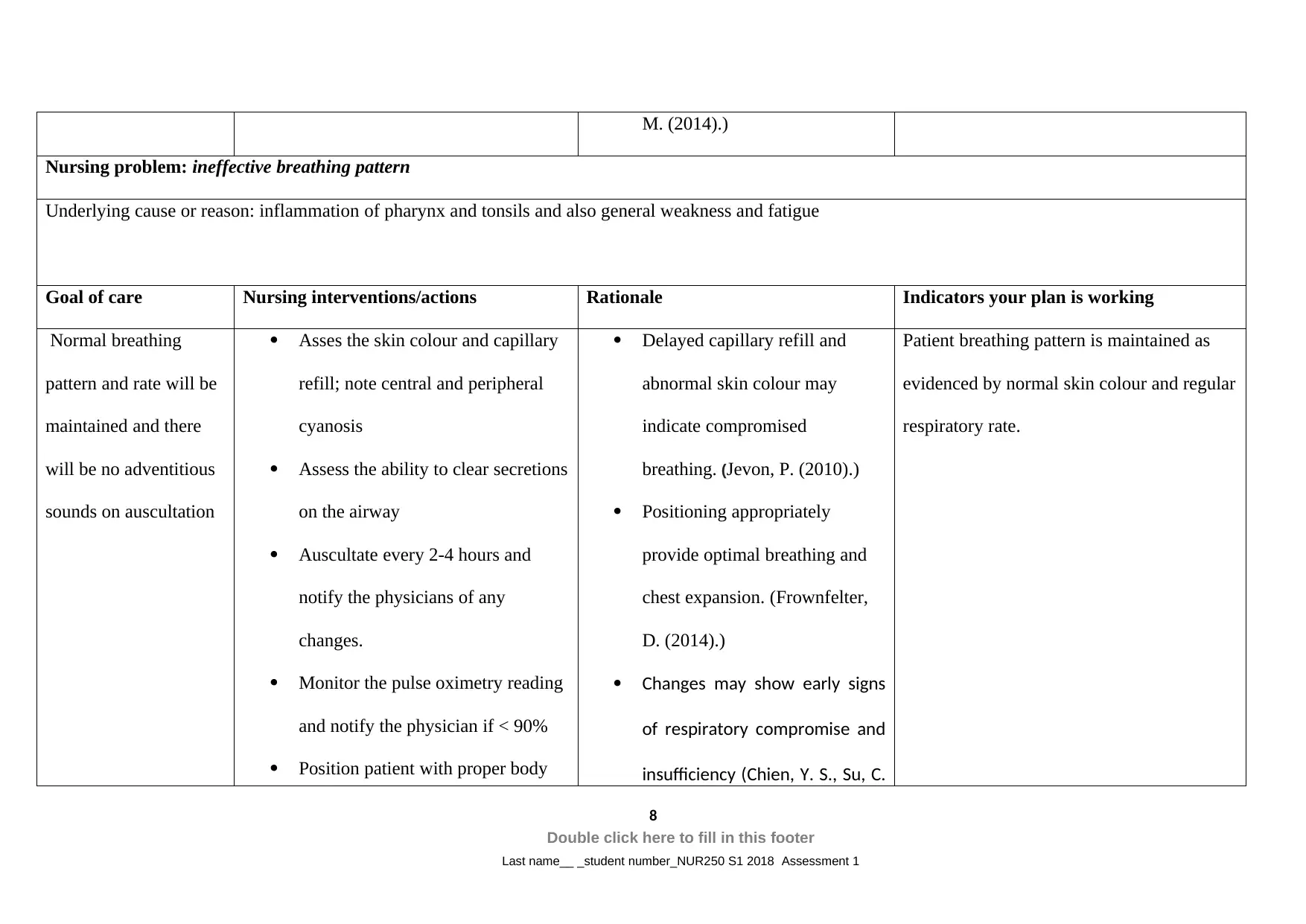
M. (2014).)
Nursing problem: ineffective breathing pattern
Underlying cause or reason: inflammation of pharynx and tonsils and also general weakness and fatigue
Goal of care Nursing interventions/actions Rationale Indicators your plan is working
Normal breathing
pattern and rate will be
maintained and there
will be no adventitious
sounds on auscultation
Asses the skin colour and capillary
refill; note central and peripheral
cyanosis
Assess the ability to clear secretions
on the airway
Auscultate every 2-4 hours and
notify the physicians of any
changes.
Monitor the pulse oximetry reading
and notify the physician if < 90%
Position patient with proper body
Delayed capillary refill and
abnormal skin colour may
indicate compromised
breathing. (Jevon, P. (2010).)
Positioning appropriately
provide optimal breathing and
chest expansion. (Frownfelter,
D. (2014).)
Changes may show early signs
of respiratory compromise and
insufficiency (Chien, Y. S., Su, C.
Patient breathing pattern is maintained as
evidenced by normal skin colour and regular
respiratory rate.
8
Double click here to fill in this footer
Last name__ _student number_NUR250 S1 2018 Assessment 1
Nursing problem: ineffective breathing pattern
Underlying cause or reason: inflammation of pharynx and tonsils and also general weakness and fatigue
Goal of care Nursing interventions/actions Rationale Indicators your plan is working
Normal breathing
pattern and rate will be
maintained and there
will be no adventitious
sounds on auscultation
Asses the skin colour and capillary
refill; note central and peripheral
cyanosis
Assess the ability to clear secretions
on the airway
Auscultate every 2-4 hours and
notify the physicians of any
changes.
Monitor the pulse oximetry reading
and notify the physician if < 90%
Position patient with proper body
Delayed capillary refill and
abnormal skin colour may
indicate compromised
breathing. (Jevon, P. (2010).)
Positioning appropriately
provide optimal breathing and
chest expansion. (Frownfelter,
D. (2014).)
Changes may show early signs
of respiratory compromise and
insufficiency (Chien, Y. S., Su, C.
Patient breathing pattern is maintained as
evidenced by normal skin colour and regular
respiratory rate.
8
Double click here to fill in this footer
Last name__ _student number_NUR250 S1 2018 Assessment 1
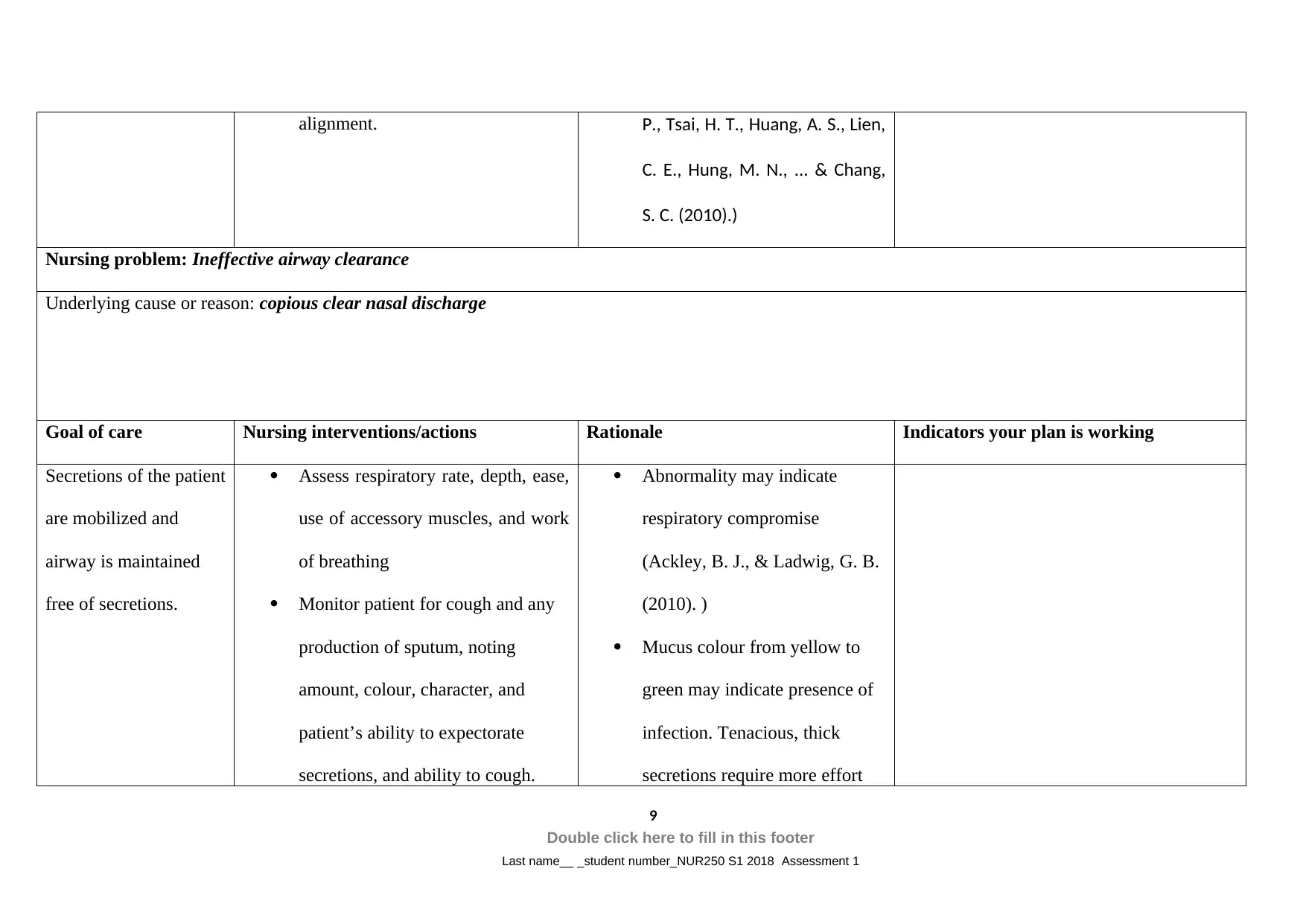
alignment. P., Tsai, H. T., Huang, A. S., Lien,
C. E., Hung, M. N., ... & Chang,
S. C. (2010).)
Nursing problem: Ineffective airway clearance
Underlying cause or reason: copious clear nasal discharge
Goal of care Nursing interventions/actions Rationale Indicators your plan is working
Secretions of the patient
are mobilized and
airway is maintained
free of secretions.
Assess respiratory rate, depth, ease,
use of accessory muscles, and work
of breathing
Monitor patient for cough and any
production of sputum, noting
amount, colour, character, and
patient’s ability to expectorate
secretions, and ability to cough.
Abnormality may indicate
respiratory compromise
(Ackley, B. J., & Ladwig, G. B.
(2010). )
Mucus colour from yellow to
green may indicate presence of
infection. Tenacious, thick
secretions require more effort
9
Double click here to fill in this footer
Last name__ _student number_NUR250 S1 2018 Assessment 1
C. E., Hung, M. N., ... & Chang,
S. C. (2010).)
Nursing problem: Ineffective airway clearance
Underlying cause or reason: copious clear nasal discharge
Goal of care Nursing interventions/actions Rationale Indicators your plan is working
Secretions of the patient
are mobilized and
airway is maintained
free of secretions.
Assess respiratory rate, depth, ease,
use of accessory muscles, and work
of breathing
Monitor patient for cough and any
production of sputum, noting
amount, colour, character, and
patient’s ability to expectorate
secretions, and ability to cough.
Abnormality may indicate
respiratory compromise
(Ackley, B. J., & Ladwig, G. B.
(2010). )
Mucus colour from yellow to
green may indicate presence of
infection. Tenacious, thick
secretions require more effort
9
Double click here to fill in this footer
Last name__ _student number_NUR250 S1 2018 Assessment 1
⊘ This is a preview!⊘
Do you want full access?
Subscribe today to unlock all pages.

Trusted by 1+ million students worldwide
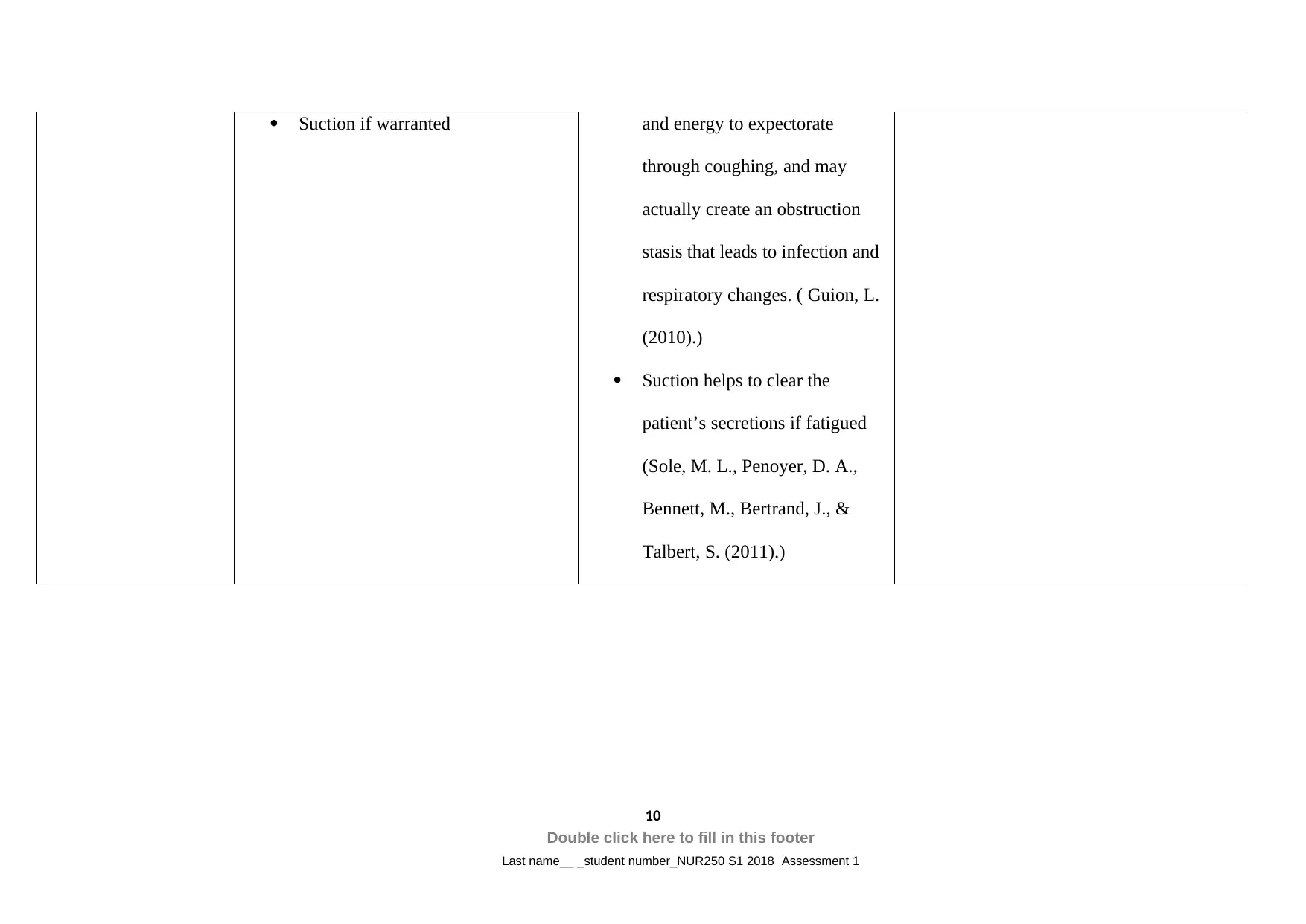
Suction if warranted and energy to expectorate
through coughing, and may
actually create an obstruction
stasis that leads to infection and
respiratory changes. ( Guion, L.
(2010).)
Suction helps to clear the
patient’s secretions if fatigued
(Sole, M. L., Penoyer, D. A.,
Bennett, M., Bertrand, J., &
Talbert, S. (2011).)
10
Double click here to fill in this footer
Last name__ _student number_NUR250 S1 2018 Assessment 1
through coughing, and may
actually create an obstruction
stasis that leads to infection and
respiratory changes. ( Guion, L.
(2010).)
Suction helps to clear the
patient’s secretions if fatigued
(Sole, M. L., Penoyer, D. A.,
Bennett, M., Bertrand, J., &
Talbert, S. (2011).)
10
Double click here to fill in this footer
Last name__ _student number_NUR250 S1 2018 Assessment 1
Paraphrase This Document
Need a fresh take? Get an instant paraphrase of this document with our AI Paraphraser
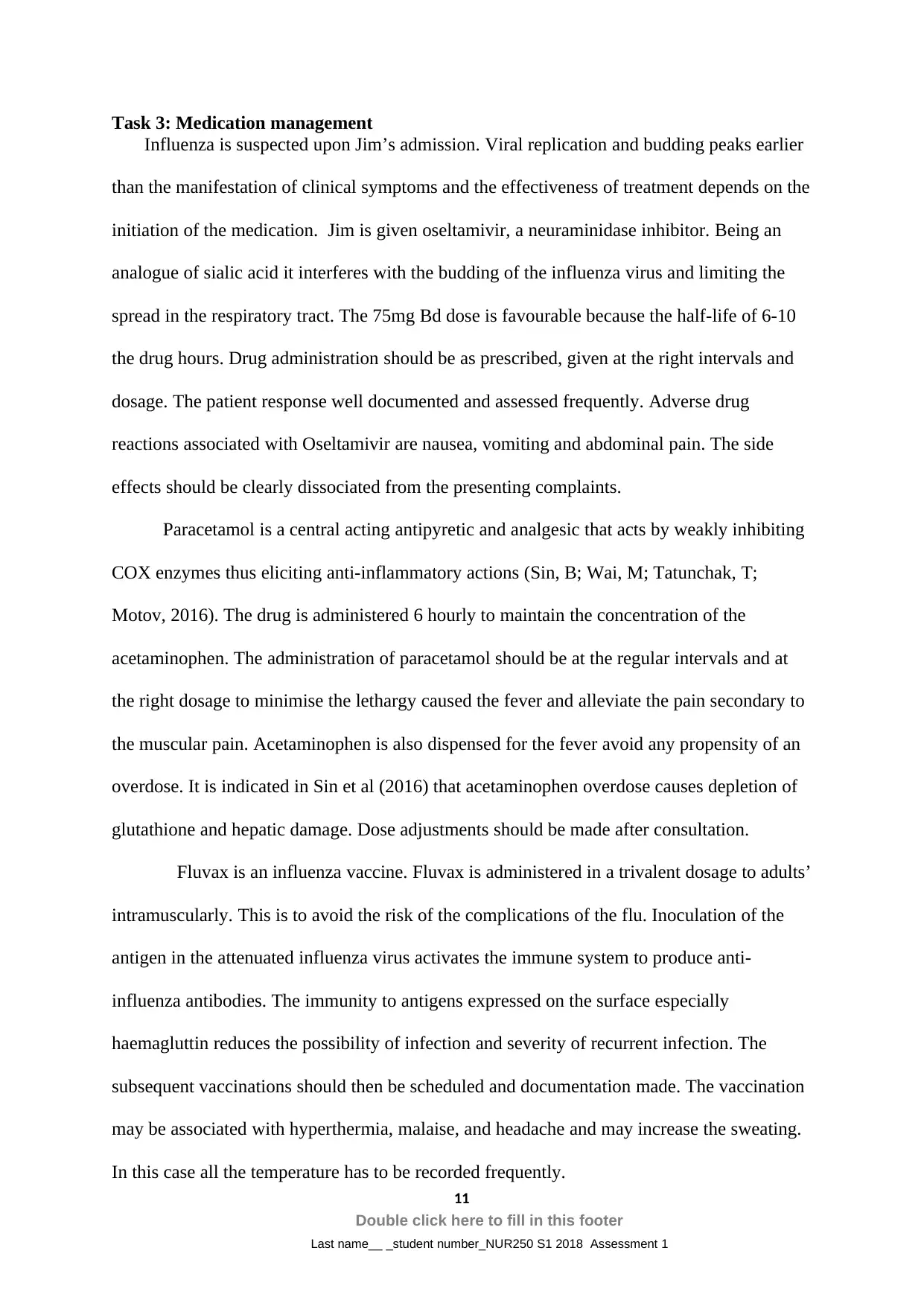
Task 3: Medication management
Influenza is suspected upon Jim’s admission. Viral replication and budding peaks earlier
than the manifestation of clinical symptoms and the effectiveness of treatment depends on the
initiation of the medication. Jim is given oseltamivir, a neuraminidase inhibitor. Being an
analogue of sialic acid it interferes with the budding of the influenza virus and limiting the
spread in the respiratory tract. The 75mg Bd dose is favourable because the half-life of 6-10
the drug hours. Drug administration should be as prescribed, given at the right intervals and
dosage. The patient response well documented and assessed frequently. Adverse drug
reactions associated with Oseltamivir are nausea, vomiting and abdominal pain. The side
effects should be clearly dissociated from the presenting complaints.
Paracetamol is a central acting antipyretic and analgesic that acts by weakly inhibiting
COX enzymes thus eliciting anti-inflammatory actions (Sin, B; Wai, M; Tatunchak, T;
Motov, 2016). The drug is administered 6 hourly to maintain the concentration of the
acetaminophen. The administration of paracetamol should be at the regular intervals and at
the right dosage to minimise the lethargy caused the fever and alleviate the pain secondary to
the muscular pain. Acetaminophen is also dispensed for the fever avoid any propensity of an
overdose. It is indicated in Sin et al (2016) that acetaminophen overdose causes depletion of
glutathione and hepatic damage. Dose adjustments should be made after consultation.
Fluvax is an influenza vaccine. Fluvax is administered in a trivalent dosage to adults’
intramuscularly. This is to avoid the risk of the complications of the flu. Inoculation of the
antigen in the attenuated influenza virus activates the immune system to produce anti-
influenza antibodies. The immunity to antigens expressed on the surface especially
haemagluttin reduces the possibility of infection and severity of recurrent infection. The
subsequent vaccinations should then be scheduled and documentation made. The vaccination
may be associated with hyperthermia, malaise, and headache and may increase the sweating.
In this case all the temperature has to be recorded frequently.
11
Double click here to fill in this footer
Last name__ _student number_NUR250 S1 2018 Assessment 1
Influenza is suspected upon Jim’s admission. Viral replication and budding peaks earlier
than the manifestation of clinical symptoms and the effectiveness of treatment depends on the
initiation of the medication. Jim is given oseltamivir, a neuraminidase inhibitor. Being an
analogue of sialic acid it interferes with the budding of the influenza virus and limiting the
spread in the respiratory tract. The 75mg Bd dose is favourable because the half-life of 6-10
the drug hours. Drug administration should be as prescribed, given at the right intervals and
dosage. The patient response well documented and assessed frequently. Adverse drug
reactions associated with Oseltamivir are nausea, vomiting and abdominal pain. The side
effects should be clearly dissociated from the presenting complaints.
Paracetamol is a central acting antipyretic and analgesic that acts by weakly inhibiting
COX enzymes thus eliciting anti-inflammatory actions (Sin, B; Wai, M; Tatunchak, T;
Motov, 2016). The drug is administered 6 hourly to maintain the concentration of the
acetaminophen. The administration of paracetamol should be at the regular intervals and at
the right dosage to minimise the lethargy caused the fever and alleviate the pain secondary to
the muscular pain. Acetaminophen is also dispensed for the fever avoid any propensity of an
overdose. It is indicated in Sin et al (2016) that acetaminophen overdose causes depletion of
glutathione and hepatic damage. Dose adjustments should be made after consultation.
Fluvax is an influenza vaccine. Fluvax is administered in a trivalent dosage to adults’
intramuscularly. This is to avoid the risk of the complications of the flu. Inoculation of the
antigen in the attenuated influenza virus activates the immune system to produce anti-
influenza antibodies. The immunity to antigens expressed on the surface especially
haemagluttin reduces the possibility of infection and severity of recurrent infection. The
subsequent vaccinations should then be scheduled and documentation made. The vaccination
may be associated with hyperthermia, malaise, and headache and may increase the sweating.
In this case all the temperature has to be recorded frequently.
11
Double click here to fill in this footer
Last name__ _student number_NUR250 S1 2018 Assessment 1
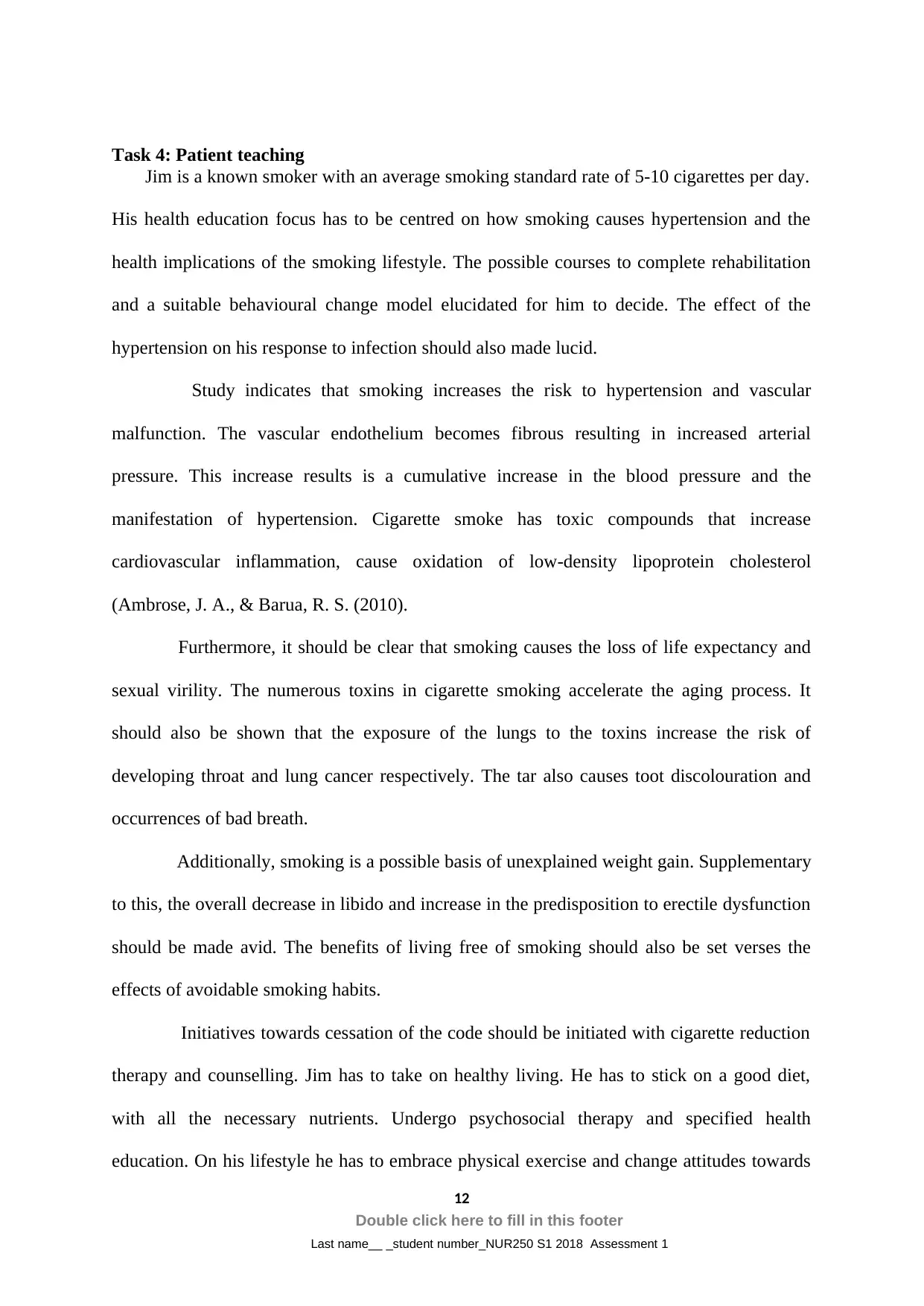
Task 4: Patient teaching
Jim is a known smoker with an average smoking standard rate of 5-10 cigarettes per day.
His health education focus has to be centred on how smoking causes hypertension and the
health implications of the smoking lifestyle. The possible courses to complete rehabilitation
and a suitable behavioural change model elucidated for him to decide. The effect of the
hypertension on his response to infection should also made lucid.
Study indicates that smoking increases the risk to hypertension and vascular
malfunction. The vascular endothelium becomes fibrous resulting in increased arterial
pressure. This increase results is a cumulative increase in the blood pressure and the
manifestation of hypertension. Cigarette smoke has toxic compounds that increase
cardiovascular inflammation, cause oxidation of low-density lipoprotein cholesterol
(Ambrose, J. A., & Barua, R. S. (2010).
Furthermore, it should be clear that smoking causes the loss of life expectancy and
sexual virility. The numerous toxins in cigarette smoking accelerate the aging process. It
should also be shown that the exposure of the lungs to the toxins increase the risk of
developing throat and lung cancer respectively. The tar also causes toot discolouration and
occurrences of bad breath.
Additionally, smoking is a possible basis of unexplained weight gain. Supplementary
to this, the overall decrease in libido and increase in the predisposition to erectile dysfunction
should be made avid. The benefits of living free of smoking should also be set verses the
effects of avoidable smoking habits.
Initiatives towards cessation of the code should be initiated with cigarette reduction
therapy and counselling. Jim has to take on healthy living. He has to stick on a good diet,
with all the necessary nutrients. Undergo psychosocial therapy and specified health
education. On his lifestyle he has to embrace physical exercise and change attitudes towards
12
Double click here to fill in this footer
Last name__ _student number_NUR250 S1 2018 Assessment 1
Jim is a known smoker with an average smoking standard rate of 5-10 cigarettes per day.
His health education focus has to be centred on how smoking causes hypertension and the
health implications of the smoking lifestyle. The possible courses to complete rehabilitation
and a suitable behavioural change model elucidated for him to decide. The effect of the
hypertension on his response to infection should also made lucid.
Study indicates that smoking increases the risk to hypertension and vascular
malfunction. The vascular endothelium becomes fibrous resulting in increased arterial
pressure. This increase results is a cumulative increase in the blood pressure and the
manifestation of hypertension. Cigarette smoke has toxic compounds that increase
cardiovascular inflammation, cause oxidation of low-density lipoprotein cholesterol
(Ambrose, J. A., & Barua, R. S. (2010).
Furthermore, it should be clear that smoking causes the loss of life expectancy and
sexual virility. The numerous toxins in cigarette smoking accelerate the aging process. It
should also be shown that the exposure of the lungs to the toxins increase the risk of
developing throat and lung cancer respectively. The tar also causes toot discolouration and
occurrences of bad breath.
Additionally, smoking is a possible basis of unexplained weight gain. Supplementary
to this, the overall decrease in libido and increase in the predisposition to erectile dysfunction
should be made avid. The benefits of living free of smoking should also be set verses the
effects of avoidable smoking habits.
Initiatives towards cessation of the code should be initiated with cigarette reduction
therapy and counselling. Jim has to take on healthy living. He has to stick on a good diet,
with all the necessary nutrients. Undergo psychosocial therapy and specified health
education. On his lifestyle he has to embrace physical exercise and change attitudes towards
12
Double click here to fill in this footer
Last name__ _student number_NUR250 S1 2018 Assessment 1
⊘ This is a preview!⊘
Do you want full access?
Subscribe today to unlock all pages.

Trusted by 1+ million students worldwide
1 out of 16
Related Documents
Your All-in-One AI-Powered Toolkit for Academic Success.
+13062052269
info@desklib.com
Available 24*7 on WhatsApp / Email
![[object Object]](/_next/static/media/star-bottom.7253800d.svg)
Unlock your academic potential
Copyright © 2020–2025 A2Z Services. All Rights Reserved. Developed and managed by ZUCOL.



